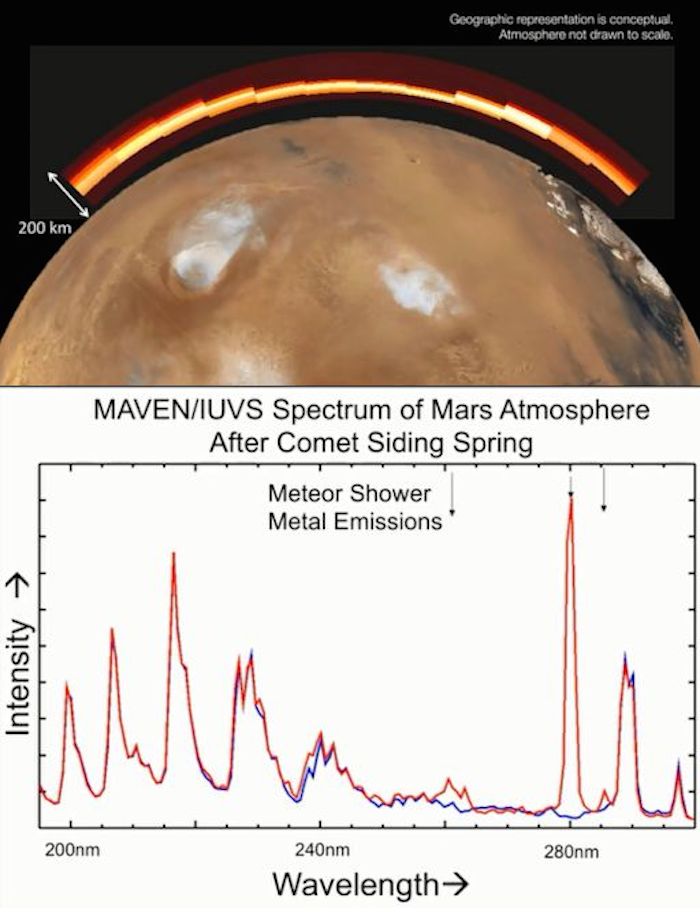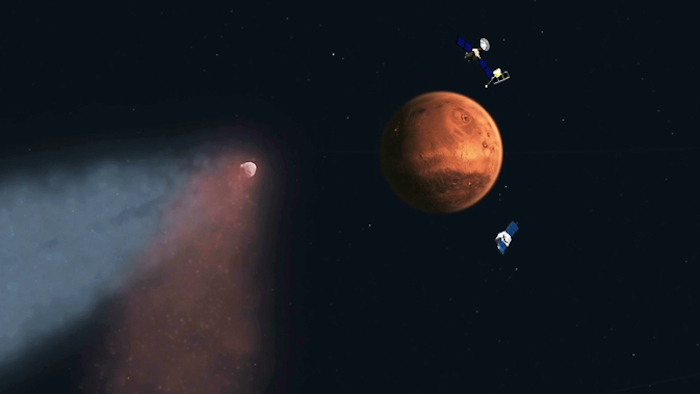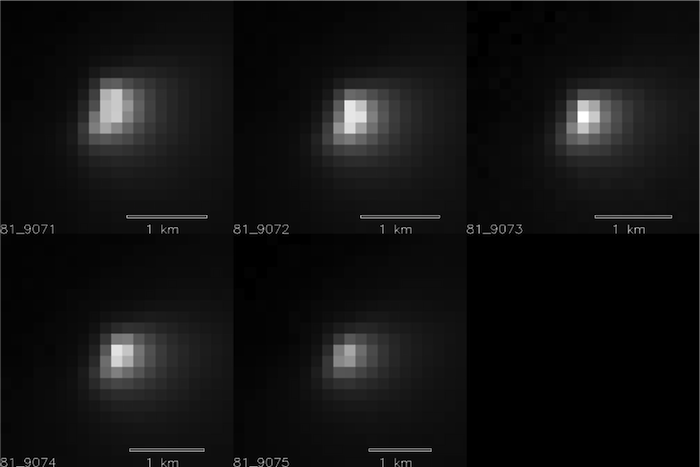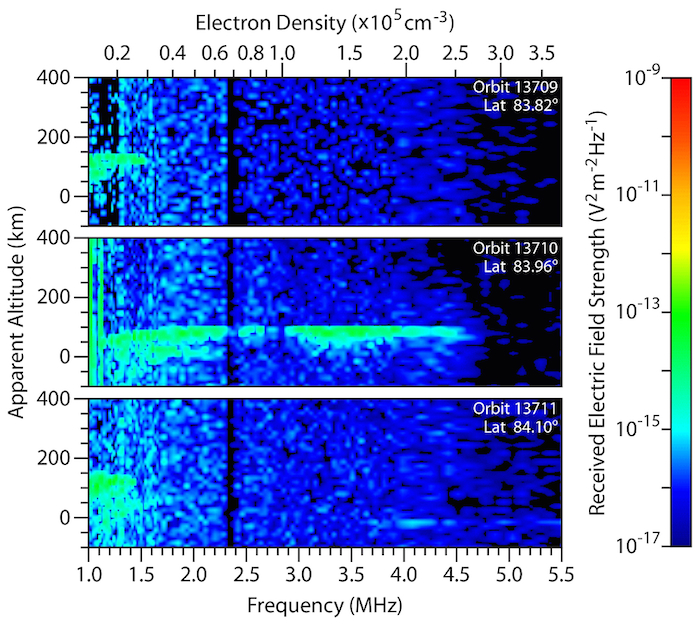.
MARTIAN METEOR SHOWER: Today, NASA held a press conference to discuss what happened when Comet Siding Springs buzzed Mars on Oct. 19, 2014. An international fleet of Mars orbiters observed the encounter using a variety of cameras, radars, and other sensors. Among many findings, the highlight was a "spectacular meteor shower" detected by NASA's MAVEN spacecraft. MAVEN did not actually see streaks of light in the Martian atmosphere--the spacecraft was sheltering behind the body of Mars during the comet's flyby. But when MAVEN emerged, it found a glowing layer of Mg+ (a constituent of meteor smoke) floating 150 km above the planet's surface:
.

The "smoke" was made of ionized magnesium and other metals shed by the disintegrating meteoroids. The data are consistent with "a few tons of comet dust being deposited in the atmosphere of Mars," says Nick Schneider, the instrument lead for MAVEN's Imaging Ultraviolet Spectrograph at University of Colorado, Boulder. "A human on the surface of Mars might have seen thousands of shooting stars per hour, possibly a meteor storm." He further speculated that the meteor shower would have produced a yellow afterglow in the skies of Mars because the meteor smoke was rich in sodium ions.
Jim Green, the director of NASA's Planetary Science Division in Washington DC says there was a lot more comet dust hitting Mars than researchers expected, pre-flyby. Radars onboard the ESA's Mars Express spacecraft and NASA's Mars Reconnassance Orbiter also detected signs of meteor-related ions. MAVEN and the other spacecraft are continuing to collect data as the atmosphere of Mars recovers from the encounter. Stay tuned for updates.
Quelle. Spaceweather
.
Mars Spacecraft Reveal Comet Flyby Effects on Martian Atmosphere
.

Artist’s concept of Comet Siding Spring approaching Mars, shown with NASA’s orbiters preparing to make science observations of this unique encounter.
Image Credit: NASA/JPL
.
Two NASA and one European spacecraft that obtained the first up-close observations of a comet flyby of Mars on Oct. 19, have gathered new information about the basic properties of the comet’s nucleus and directly detected the effects on the Martian atmosphere.
Data from observations carried out by NASA's Mars Atmosphere and Volatile Evolution (MAVEN) mission, NASA’s Mars Reconnaissance Orbiter (MRO), and a radar instrument on the European Space Agency's (ESA’s) Mars Express spacecraft have revealed that debris from the comet added a temporary and very strong layer of ions to the ionosphere, the electrically charged layer high above Mars. In these observations, scientists were able to make a direct connection from the input of debris from a specific meteor shower to the formation of this kind of transient layer in response; that is a first on any planet, including Earth.
Comet C/2013 A1 Siding Spring traveled from the most distant region of our solar system, called the Oort Cloud, and made a close approach around 2:27 p.m. EDT within about 87,000 miles (139,500 kilometers) of the Red Planet. This is less than half the distance between Earth and our moon and less than one-tenth the distance of any known comet flyby of Earth.
Dust from the comet impacted Mars and was vaporized high in the atmosphere, producing what was likely an impressive meteor shower. This debris resulted in significant temporary changes to the planet’s upper atmosphere and possible longer-term perturbations. Earth-based and a host of space telescopes also observed the unique celestial object.
“This historic event allowed us to observe the details of this fast-moving Oort Cloud comet in a way never before possible using our existing Mars missions,” said Jim Green, director of NASA’s Planetary Science Division at the agency’s Headquarters in Washington. “Observing the effects on Mars of the comet's dust slamming into the upper atmosphere makes me very happy that we decided to put our spacecraft on the other side of Mars at the peak of the dust tail passage and out of harm's way.”
The MAVEN spacecraft, recently arrived at Mars, detected the comet encounter in two ways. The remote-sensing Imaging Ultraviolet Spectrograph observed intense ultraviolet emission from magnesium and iron ions high in the atmosphere in the aftermath of the meteor shower. Not even the most intense meteor storms on Earth have produced as strong a response as this one. The emission dominated Mars' ultraviolet spectrum for several hours after the encounter and then dissipated over the next two days.
MAVEN also was able to directly sample and determine the composition of some of the comet dust in Mars’ atmosphere. Analysis of these samples by the spacecraft’s Neutral Gas and Ion Mass Spectrometer detected eight different types of metal ions, including sodium, magnesium and iron. These are the first direct measurements of the composition of dust from an Oort Cloud comet. The Oort Cloud, well beyond the outer-most planets that surround our sun, is a spherical region of icy objects believed to be material left over from the formation of the solar system.
Elsewhere above Mars, a joint U.S. and Italian instrument on Mars Express observed a huge increase in the density of electrons following the comet's close approach. This instrument, the Mars Advanced Radar for Subsurface and Ionospheric Sounding (MARSIS), saw a huge jump in the electron density in the ionosphere a few hours after the comet rendezvous. This spike occurred at a substantially lower altitude than the normal density peak in the Martian ionosphere. The increased ionization, like the effects observed by MAVEN, appears to be the result of fine particles from the comet burning up in the atmosphere.
MRO’s Shallow Subsurface Radar (SHARAD) also detected the enhanced ionosphere. Images from the instrument were smeared by the passage of the radar signals through the temporary ion layer created by the comet's dust. SHARAD scientists used this smearing to determine that the electron density of the ionosphere on the planet's night side, where the observations were made, was five to 10 times higher than usual.
Studies of the comet itself, made with MRO's High Resolution Imaging Science Experiment (HiRISE) camera, revealed the nucleus is smaller than the expected 1.2 miles (2 kilometers). The HiRISE images also indicate a rotation period for the nucleus of eight hours, which is consistent with recent preliminary observations by NASA’s Hubble Space Telescope.
MRO’s Compact Reconnaissance Imaging Spectrometer for Mars (CRISM) also observed the comet to see whether signs of any particular chemical constituents stood out in its spectrum. Team members said the spectrum appears to show a dusty comet with no strong emission lines at their instrument’s sensitivity.
In addition to these immediate effects, MAVEN and the other missions will continue to look for long-term perturbations to Mars’ atmosphere.
MAVEN's principal investigator is based at the University of Colorado's Laboratory for Atmospheric and Space Physics in Boulder, and NASA's Goddard Space Flight Center in Greenbelt, Maryland, manages the mission. NASA's Jet Propulsion Laboratory, a division of Caltech in Pasadena, manages the Mars Reconnaissance Orbiter. Mars Express is a project of the European Space Agency; NASA and the Italian Space Agency jointly funded the MARSIS instrument.
.

Mars Orbiter Sizes Up Passing Comet
Five images of comet C/2013 A1 Siding Spring taken within a 35-minute period as it passed near Mars on Oct. 19, 2014, provide information about the size of the comet's nucleus. These observations by the High Resolution Imaging Science Experiment (HiRISE) camera on NASA's Mars Reconnaissance Orbiter suggest that the nucleus is smaller than 1.2 miles (2 kilometers) across.
HiRISE acquired these images from distances ranging from 86,000 to 93,000 miles (138,000 to 150,000 kilometers) away from the nucleus, as comet Siding Spring made its closest approach to Mars. At those distances, each pixel covers an area from about 450 to 580 feet (138 to 177 meters). The scale bar on each image is 0.62 mile (1 kilometer).
The HiRISE observations of comet Siding Spring during this period were made possible due to very precise pointing and slewing of the Mars Reconnaissance Orbiter by engineers at Lockheed Martin in Denver, based on comet position calculations by engineers at NASA's Jet Propulsion Laboratory, Pasadena, California. HiRISE acquired three images 12 days before closest approach, when the comet was barely detectable above the "noise level" of the images. These early images indicated the comet was not quite at its predicted location. This new viewing angle on the comet was used to update its predicted location and timing at closest approach. Without this update, the comet may have been outside the HiRISE image area in the best images.
For more information on these and other HiRISE images, see http://hirise.lpl.arizona.edu.
HiRISE is one of six instruments on NASA's Mars Reconnaissance Orbiter. The University of Arizona, Tucson, operates HiRISE, which was built by Ball Aerospace & Technologies Corp., Boulder, Colorado. JPL, a division of the California Institute of Technology in Pasadena, manages the Mars Reconnaissance Orbiter Project for NASA's Science Mission Directorate, Washington.
Image Credit: NASA/JPL-Caltech/University of Arizona
.

Radar-Detected Change in Martian Near-Polar Ionosphere After Comet's Flyby
Quelle: NASA
3981 Views

